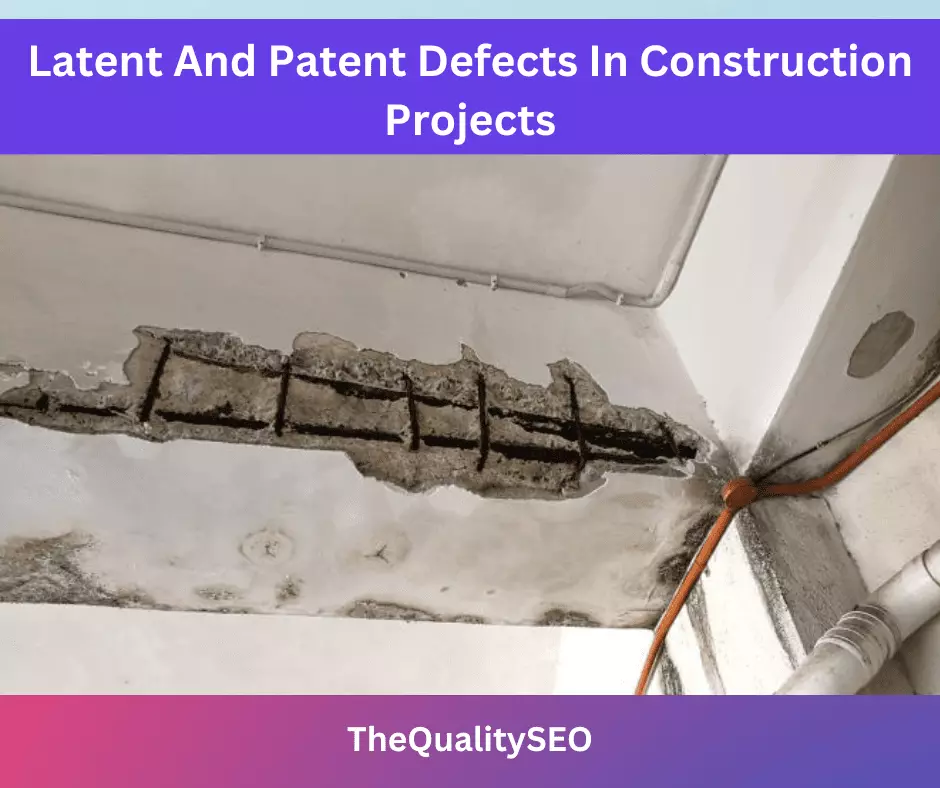Table of Contents
In this article, we will discuss latent and patent defects in construction projects.
| Summary: Construction defects are generated as a result of different deficiencies such as poor building materials and workmanship or faulty design. They can be classified into patent or latent defects. Patent (visible) defects are defects that can be seen by reasonable inspection, while latent (hidden) defects are hidden defects or problems within the structure that are not easily discovered. Latent defects may stay undetected for years, before ultimately making themselves observable and becoming patent defects. |
1. Latent And Patent Defects In Construction Projects
a. Patent Defects
Patent defects are defects that are entirely visible to the naked eye-for example, faulty pipes, water stains on the walls, wall cracks, etc.
A practical completion certificate is a contractual document that permits the client to take possession of and utilize a building. All the defects apparent before the practical completion of the project should be repaired before giving the certificate of practical completion.
After issuing the practical completion certificate, the defects liability period starts. During the defects liability or rectification period, the client can report any defects to the contractor. Once they are repaired, a certificate of making good defects (CMGD) (now called the certificate of making good) is allocated to the client.
If faults occur even after certifying CMGD, they must be removed completely before giving the contractor the final completion certificate. A final certificate is a certification by the contract administrator indicating that a construction contract has been fully satisfied.
The value of the final certificate is established on the final accounts which means all the patent defects are cured, any adjustments to the contract sum are approved and all claims are resolved.
2. How to Deal with Patent Defects?
Patent defects are often dealt with during frequent inspections and become a part of snagging as they are surface defects. The snag list is presented and updated by the contractor within a reasonable timeframe.
b. Latent Defects
Some faults and defects in construction projects pushed by failures in design, workmanship, or materials may not become noticeable until many years after fulfillment of the project, or long after the defects liability period. These defects are called latent defects.
Defective basement, movement or damage of wall due to insufficient wall linkages, poor strength concrete issues, error in reinforcing the structure, or building cracks due to insufficient foundation are a few samples of latent defects.
Compared to patent defects, latent defects are complicated to determine and resolve during the construction period or defect liability period. Hence, there is no contractual right that obliges the contractor to fix it.
3. How to Deal With Latent Defects in Construction?
The building owner does not have a contractual right to compel the contractor to correct any latent defect that is observed after the defects liability period. But, as most latent defects are concealed flaws and are mostly located after this period, the owner can seek redress in an action for breach of contract or for negligence.
Another solution is to equip a dilapidation report to capture possible latent defects. An expert can check and forecast future possibilities of defects caused due to poor planning or workmanship during the design or construction phase. Without a dilapidation report, the contractor can shift the blame on the owner for a latent defect caused.
Other solutions include:
a. Building insurance for structural damage and defects to roofs, walls, or foundations.
b. Latent defect insurance that covers defects in design, workmanship, or materials that becomes apparent after the defect liability period.
Latent defects are a matter of significant consideration when one is conceiving to buy a property. A seller has no responsibility to inform existing patent or latent defects in the building, but if attempts to hide any, it is referred to in law as fraudulent concealment.
It is recommended that a purchaser, seller, property inspector, or real estate agent/broker involved in a latent defect argument acquire legal advice from a qualified lawyer for better settlement of disputes.
4. FAQ
| What are Patent Defects? | Patent defects are defects that are entirely visible to the naked eye-for example, faulty pipes, water stains on the walls, wall cracks, etc. |
| What are Latent Defects? | Latent defects are defects that are not apparent or readily detectable until years after a project is completed when the defects liability period is over. |
| What are examples of Latent Defects? | They include damage inside walls (such as pipes), a leaking roof with no obvious leak marks, or electrical issues. |
Read Also: Must Haves For Building

